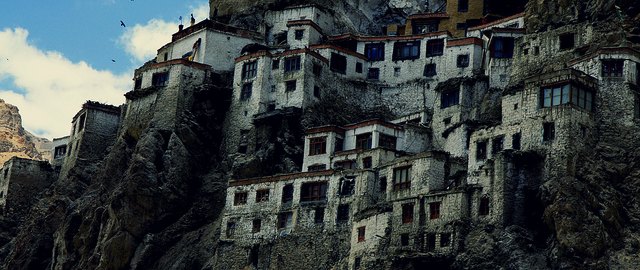
Phuktal Gompa
We had been warned that the trek to Phuktal Gompa, set deep in the Zanskar valley, would not be an easy one. So, in spite of Chong’s assurances, we started out in the morning with a little bit of trepidation. But it turned out to be one of the finest days of our 5-day trek!
Beyond Purne the landscape changes subtly but it’s immediately 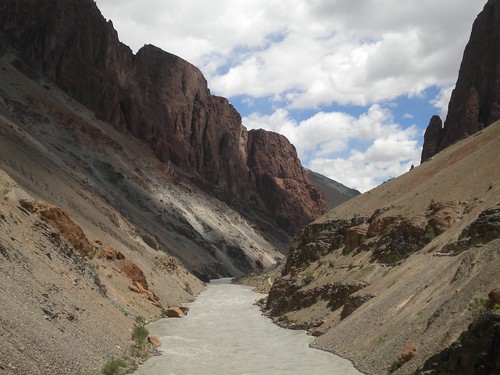 noticeable! The color and formation of the rocky mountains that line either side of the Lungnak river suddenly started to take on a Grand Canyon-esque look! Madhu and I were completely over-awed! The trail continued to have its ups and downs just like the previous day but the scenery was so fantastic that we almost ignored the stress. Moreover, at places the rock formations jutted out above the trail giving us a few shaded spots to take a break and lounge; it was awesome!
noticeable! The color and formation of the rocky mountains that line either side of the Lungnak river suddenly started to take on a Grand Canyon-esque look! Madhu and I were completely over-awed! The trail continued to have its ups and downs just like the previous day but the scenery was so fantastic that we almost ignored the stress. Moreover, at places the rock formations jutted out above the trail giving us a few shaded spots to take a break and lounge; it was awesome!
Along the way, we met 3 young guys from Bihar who 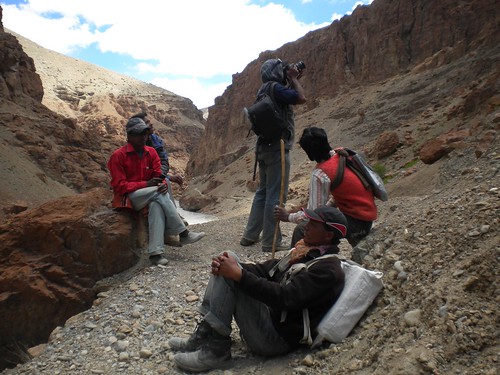 were also on their way to the monastery. We bumped into them during one of our breaks and got talking. They turned out to be painters hired by the Phuktal Gompa to paint Buddhist murals on the interior walls of their newly constructed prayer halls. One of them does the sketching while the others fill it in with paint. They were planning to stay at the Gompa’s guesthouse for about a week, until the work got done.
were also on their way to the monastery. We bumped into them during one of our breaks and got talking. They turned out to be painters hired by the Phuktal Gompa to paint Buddhist murals on the interior walls of their newly constructed prayer halls. One of them does the sketching while the others fill it in with paint. They were planning to stay at the Gompa’s guesthouse for about a week, until the work got done.
Phuktal Gompa sits on the right bank of the Lungnak river, s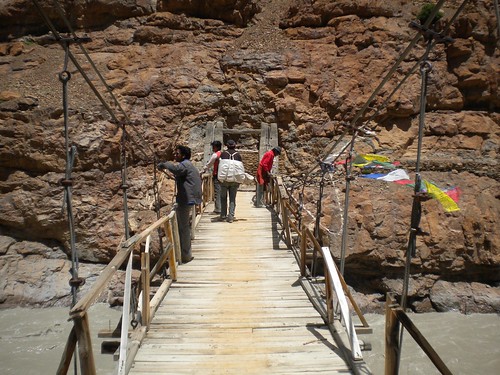 o we had to cross over on a rope bridge, which gave us the opportunity to stand over the raging waters and soak in the atmosphere; it was absolutely wonderful! Once across, we climbed a winding, steep path on the adjoining cliff. Up until this point we had not had a glimpse of the monastery but when we rounded a bend, it suddenly rose before us and almost shocked us with its location! Just before us was a rectangular Ladakhi structure, which turned out to be the guesthouse where the Bihari boys were going to be put up.
o we had to cross over on a rope bridge, which gave us the opportunity to stand over the raging waters and soak in the atmosphere; it was absolutely wonderful! Once across, we climbed a winding, steep path on the adjoining cliff. Up until this point we had not had a glimpse of the monastery but when we rounded a bend, it suddenly rose before us and almost shocked us with its location! Just before us was a rectangular Ladakhi structure, which turned out to be the guesthouse where the Bihari boys were going to be put up. 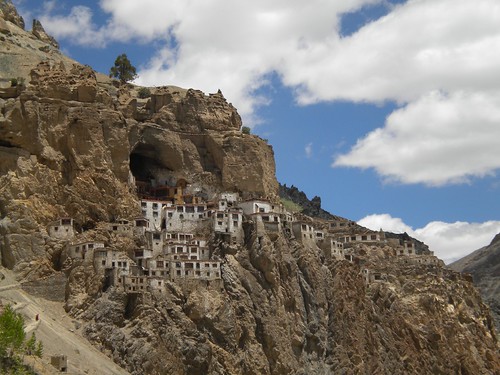 And right behind it clinging to the rock face was a huge tumble of white-washed buildings. It was an unbelievable sight! We had read and heard that the location of Phuktal Gompa was quite spectacular but seeing it in person was just out of the world! We also realized that to get to those cluster of buildings, we had a steep climb ahead of us. But it was surely going to be worth it!
And right behind it clinging to the rock face was a huge tumble of white-washed buildings. It was an unbelievable sight! We had read and heard that the location of Phuktal Gompa was quite spectacular but seeing it in person was just out of the world! We also realized that to get to those cluster of buildings, we had a steep climb ahead of us. But it was surely going to be worth it!
The climb up was indeed steep and hard, and took a good 20minutes. But as we got higher the view behind us got unbelievably gorgeous; it kept us going. At the top, we found that the original Phuktal Gompa was at the highest point of all the structures there and was built into a real cave; it was fascinating! However, today it is in a poor state with peeling murals and broken walls. A large Stupa sits in the center of the cave floor. Building material like paint cans and large pieces of wood lay strewn near the entrance to the cave and added to the chaos around. This was due to the brand new prayer hall that is being built right next door. It is a 2-storied structure painted in traditional Ladakhi colors of red, black and yellow. Most of the work on its facade is complete but some of the finishing touches still need to be added to the interiors. And that’s what our Bihari friends were there for. The prayer hall had a large, beautiful, seated image of Lord Buddha. Unfortunately, we weren’t allowed to take pictures inside!
After visiting the cave Gompa, we had to wait around for a while till a Lama stopped by to open the doors of the new prayer hall for us. We had  inadvertently turned up during their lunch time. So all the Lamas were busy, either serving food on the terrace before the prayer hall or eating! We saw them serving food to young Lamas as well who watched us curiously from a distance. While we waited on the steps of the cave Gompa, we were served with cups of butter tea. Later after we had visited the prayer hall, they offered us more tea and some wonderful Tibetan bread that we wolfed down hungrily. They were all so warm and friendly!
inadvertently turned up during their lunch time. So all the Lamas were busy, either serving food on the terrace before the prayer hall or eating! We saw them serving food to young Lamas as well who watched us curiously from a distance. While we waited on the steps of the cave Gompa, we were served with cups of butter tea. Later after we had visited the prayer hall, they offered us more tea and some wonderful Tibetan bread that we wolfed down hungrily. They were all so warm and friendly!
Below the new prayer hall is an older one, which was much smaller and not as grand. Here we made a small donation towards the restoration and preservation of the lovely complex. For this we promptly received a receipt. As we exited from here, we could look down at the rest of the white-washed, Ladakhi structures in the complex; they included residences of the Lamas and monastic schools where they taught the young. As we trudged back to Purne, we were super-tired but felt elated at having had the chance to visit this wonderfully remote monastery!
Later in the evening, for Rs.50 per bucket of hot (okay, lukewarm) water, Madhu and I were able to bathe in the outside bathroom and felt quite refreshed. As we sat on the chairs outside the store enjoying the village scenery, a large pack of horses trotted in with supplies, presumably from Padum. They were beautiful animals! The men accompanying them started unloading the supplies and suddenly the scene turned into one from a Hollywood western. Since it got too cold to be sitting outside, we hurried back to the comfort of our room, but Madhu spent most of the evening, by the window, watching the scene outside as the animals were completely unloaded and then led up to a grassy patch in the neighboring hills for grazing!
Our 2nd and last night in Purne was spent enjoying the company of our hosts again over glasses of Chhang and a wonderful meal. The following morning after a hearty breakfast of omelets and thick rotis, we bid them all goodbye and were almost a little sad about it. The whole Purne experience had been fantastic!
For our 4th night’s stay we were scheduled to stay in the village of Anmo, which lies close to Chatang (the village we stayed at on the 1st night of the trek) but on the other bank. Chong warned us that the bridge to the other bank is quite rickety and that if we found it too dangerous, we would have to spend the night at Chatang. On hearing that I was determined to not find the bridge too dangerous – I really didn’t want to stay in Chatang again! But I had no idea what we were in for until we actually got to the bridge 4 hours later¦
The bridge across the Lungnak river to the village of Anmo is a rope 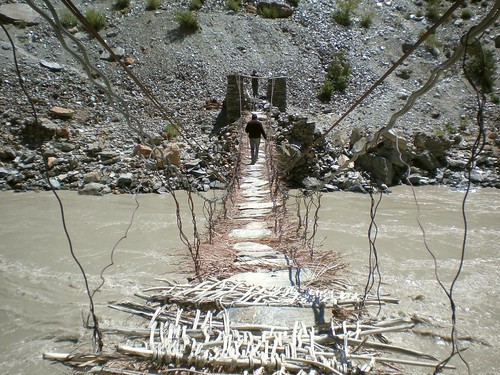 suspension bridge, which means that it sways crazily when one steps on it. But that was not the scary part. While most suspension bridges have a strong base of tightly-woven rope on which to place one’s foot, the one in Ladakh had a pile of uneven slabs of rock and dried twigs scattered over a loosely roped bottom. The gaps between these ropes were so large that the stones swayed dangerously if the footing was not balanced on them correctly! Chong offered to walk us across the bridge one at a time. He grabbed a long, strong stick for support, took hold of one of my arms and slowly guided me across. I don’t remember much of what happened during that crossing ‘coz I concentrated as hard as I could on keeping my balance on the bridge and not falling through the gaps into the raging water below in retrospect, I can’t believe I attempted something like that especially since I’m terribly afraid of water, not having even learnt to swim! But obviously, we did make it across safely. After us a couple of women from Anmo, one of whom turned out to be our host, giggled their way across the bridge, expertly balancing a bundle of dry wood on their head; we couldn’t believe our eyes!
suspension bridge, which means that it sways crazily when one steps on it. But that was not the scary part. While most suspension bridges have a strong base of tightly-woven rope on which to place one’s foot, the one in Ladakh had a pile of uneven slabs of rock and dried twigs scattered over a loosely roped bottom. The gaps between these ropes were so large that the stones swayed dangerously if the footing was not balanced on them correctly! Chong offered to walk us across the bridge one at a time. He grabbed a long, strong stick for support, took hold of one of my arms and slowly guided me across. I don’t remember much of what happened during that crossing ‘coz I concentrated as hard as I could on keeping my balance on the bridge and not falling through the gaps into the raging water below in retrospect, I can’t believe I attempted something like that especially since I’m terribly afraid of water, not having even learnt to swim! But obviously, we did make it across safely. After us a couple of women from Anmo, one of whom turned out to be our host, giggled their way across the bridge, expertly balancing a bundle of dry wood on their head; we couldn’t believe our eyes!
If the bridge crossing was crazy, the 45degree inclined hill,  which we had to climb to get to Anmo, was far worse. The foot-trail leading to the top was narrow and slippery with sliding mud. We climbed with the support of sticks and at times on all four limbs. How Chong managed to climb it with our backpack on his shoulders is beyond me! But we made it up there safely and at the end of it all felt like we had survived an attempt on our lives with the crossing and the climb! Thankfully our home-stay at Mr. Samphal’s home turned out to be super-cute and that totally made up for the dangers we undertook to get to it!
which we had to climb to get to Anmo, was far worse. The foot-trail leading to the top was narrow and slippery with sliding mud. We climbed with the support of sticks and at times on all four limbs. How Chong managed to climb it with our backpack on his shoulders is beyond me! But we made it up there safely and at the end of it all felt like we had survived an attempt on our lives with the crossing and the climb! Thankfully our home-stay at Mr. Samphal’s home turned out to be super-cute and that totally made up for the dangers we undertook to get to it!
Mr. Tashi’s organization trains the home-stay hosts on how to prepare a room for guests, what to offer as services and meals, and how to interact with the guests. For the guests, it posts a list of Dos and Donts in the room so that we don’t offend our hosts and/or their way of life. This ensures a great overall experience for both the visitors as well as the hosts. We were shown to our room which was on the upper floor of the house; it was quite neat and tidy! Clean bedding and comforters were provided along with a couple of plastic chairs and a low Ladakhi table. A Ladakhi toilet was on the same floor as our room and was for our use exclusively. A solar-charged light-bulb provided ample light in the evening. On arrival we were served with hot tea and a snack of rotis with butter and jam; it was extremely comforting!
Anmo is a tiny hamlet with about 3 or 4 homes whose residents 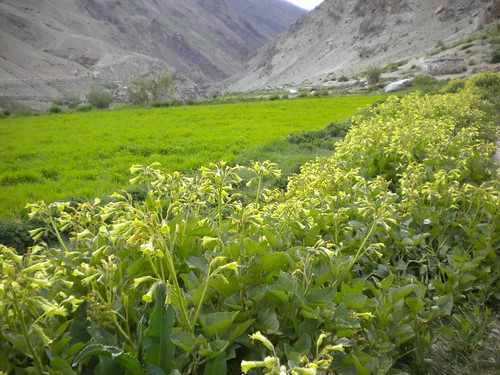 are all part of Samphal’s family. It has lovely terraced fields and a lovely, gushing stream, which is the water source for the families as well as the fields. Refreshed after the snack, we walked around here and to the long Mani wall that borders the southern end of the hamlet. Then we walked back to the northern end and sat on a large boulder gazing out at the wonderful river flowing below and the village of Chatang across; absolutely mesmerizing!
are all part of Samphal’s family. It has lovely terraced fields and a lovely, gushing stream, which is the water source for the families as well as the fields. Refreshed after the snack, we walked around here and to the long Mani wall that borders the southern end of the hamlet. Then we walked back to the northern end and sat on a large boulder gazing out at the wonderful river flowing below and the village of Chatang across; absolutely mesmerizing!
We had dinner and of course, Chhang, with Samphal, his wife, their kids and his parents who live with them. His father was a very jovial person and in spite of a language barrier managed to converse with us and keep us entertained! Samphal’s wife was very sweet and friendly too, and importantly, was a good cook . Samphal was a quiet, intelligent guy who spoke to us in length about the life of the Ladakhis and the changes the new roads are likely to bring to their currently peaceful and uncomplicated lives; it was one of the most interesting conversations we had in Ladakh!
The following morning we had breakfast with the family and set out on the last leg of our journey. Before leaving, Samphal casually mentioned to us that the trail from Anmo to Icher, on the river’s right bank, had not been cleared completely of the debris that the landslides had caused and therefore, parts of the trail could be a little difficult to walk on. He asked us not to worry and just follow Chong. This last statement worried us and we wondered what we were up against. We didn’t have to wait for long to find out.
Aziz (Mark Guesthouse owner) had mentioned to us that the trail between the villages of Icher and Anmo were very narrow and therefore  not the best to walk on comfortably. This was one of the reasons (and the one we had completely forgotten about until now) he had asked us to use the trail on the left bank of the river instead. That trail was wider and used by horses as well and therefore better maintained than the one we were on. The memory of this conversation came flooding back to us when, within 10 minutes of leaving Anmo behind, there was suddenly no sign of a trail in front of us; it had been completely covered by a landslide! Chong walked ahead of us and used his stick and his shoes to carve out temporary footholds for us on the hill. Madhu and I stood dumbstruck staring at him for a few minutes before realizing that we had no option but to follow him, tentatively placing our feet exactly where he wanted us to. It was downright scary because the debris under our feet was loose and a single slip could take us sliding down to the water within seconds. We crossed each landslide area, of which there were many, with complete concentration and a prayer on our lips. Thankfully, we made it across without any mishaps; Chong looked relieved too.
not the best to walk on comfortably. This was one of the reasons (and the one we had completely forgotten about until now) he had asked us to use the trail on the left bank of the river instead. That trail was wider and used by horses as well and therefore better maintained than the one we were on. The memory of this conversation came flooding back to us when, within 10 minutes of leaving Anmo behind, there was suddenly no sign of a trail in front of us; it had been completely covered by a landslide! Chong walked ahead of us and used his stick and his shoes to carve out temporary footholds for us on the hill. Madhu and I stood dumbstruck staring at him for a few minutes before realizing that we had no option but to follow him, tentatively placing our feet exactly where he wanted us to. It was downright scary because the debris under our feet was loose and a single slip could take us sliding down to the water within seconds. We crossed each landslide area, of which there were many, with complete concentration and a prayer on our lips. Thankfully, we made it across without any mishaps; Chong looked relieved too.
Below the village of Icher, we crossed the Lungnak River 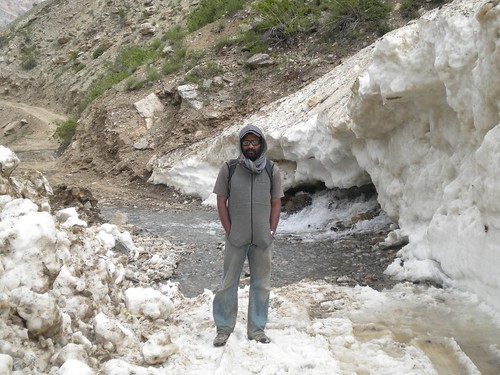 over a sturdier bridge to the left bank. From here the walk back to the point where we had been dropped off was fairly easy except for the 3 snow piles that we had encountered on our first day – they hadn’t melted completely and instead had become more dangerous because of all the melting slush. En route we saw a few stray horses who came quite close to us and stood around amiably; loved their company!
over a sturdier bridge to the left bank. From here the walk back to the point where we had been dropped off was fairly easy except for the 3 snow piles that we had encountered on our first day – they hadn’t melted completely and instead had become more dangerous because of all the melting slush. En route we saw a few stray horses who came quite close to us and stood around amiably; loved their company!
Just as promised our driver showed up to pick us up at around 2pm. We stopped in Raru for a lunch of MAGGI (Ladakh probably accounts for a large chunk of Maggi’s sales in India) and eggs before heading back to Padum. We checked back into Mark’s Guesthouse where they had, gratefully, saved a room for us; nothing like a hot shower, a lovely meal and a comfortable bed after a hard, multi-day trek!
There’s no better way of experiencing Zanskar than on foot! If we had left there without undertaking this trek, we would have missed out on a lot! It will definitely go down in our travelogue as one of our top India experiences!


Madhu reminds me of that guy from Maachis..:) with his bearded look.
hey S & T, kaisi ho ?
Hi Rajesh,
Welcome to our blog. Zanskar is indeed one of our favorite places. The fact that it is so remote makes it all the more interesting. We keep checking your blog posts via IndiBlogger.
Cheers,
Madhu